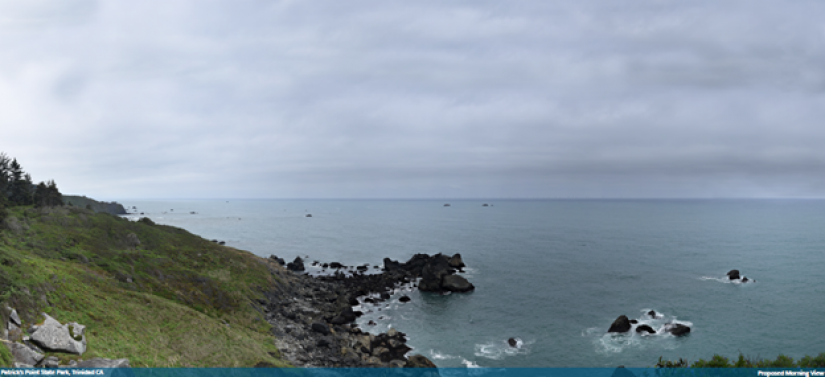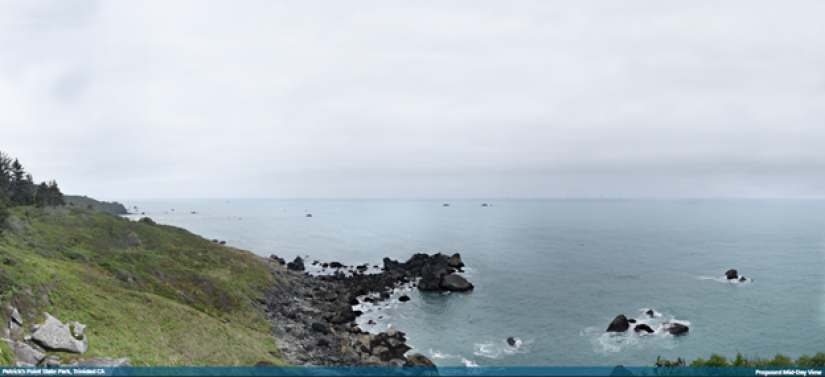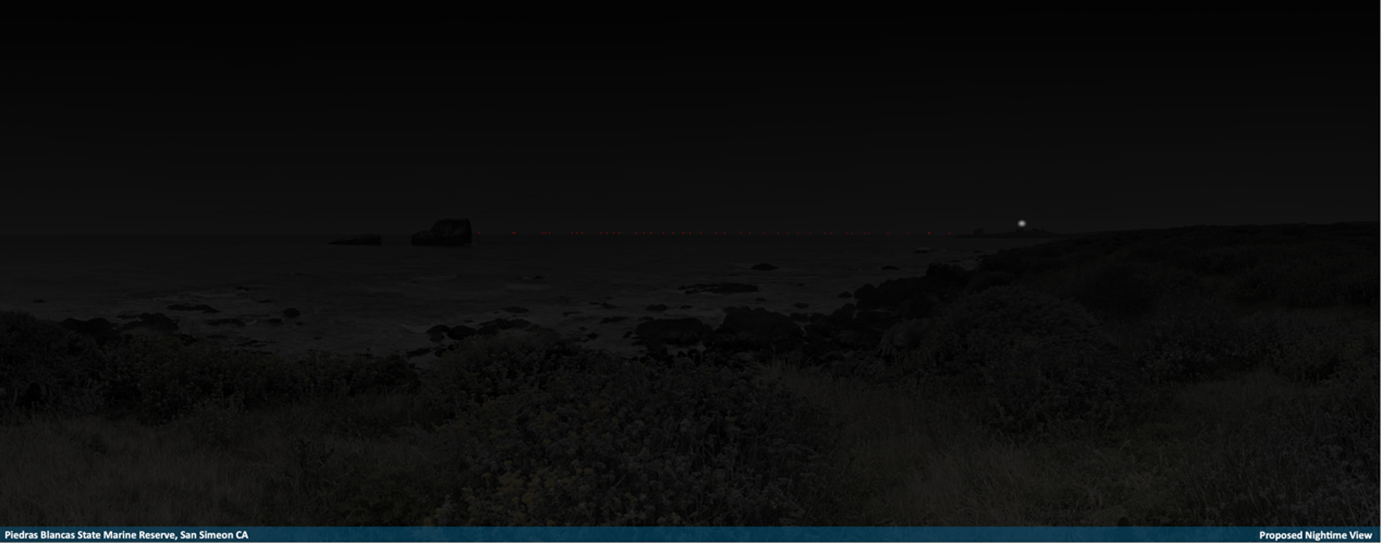Breadcrumb
- California Offshore Winds
- Visual Impacts
Visual Impacts
- Will you be able to see these from the shore?
Depending on the vantage point, time of day, and weather, the California Wind Energy Projects may be visible from shore. The closest wind energy lease area is 20 miles offshore and the furthest is 60 miles offshore. Visual simulations from key observation points during different times of the day were prepared in response to stakeholder interest in visual impacts from potential future renewable energy development and can be downloaded on BOEM’s website “California Visual Simulation”. The visual simulations model 67 15MW turbines with hub height 486 ft, and a maximum height at the blade tip of 889 ft. At night, it may also be possible to see lights on turbines.
The images below show visual simulations the Humboldt Bay Wind Energy Area of wind turbines 20 miles away from Su-meg State Park [1].
1. Simulated morning view of offshore wind turbines 20 miles offshore Su-meg State Park

2. Simulated mid-day view of offshore wind turbine 20 miles offshore Su-meg State Park

- Why are there lights on the turbines?
The Federal Aviation Administration (FAA) has requirements about how wind turbines should be marked and lit to maintain a safe airspace for aviation and enhance visibility for pilots, however the FAA’s jurisdiction only applies to 12 Nautical Miles (NM)(1 NM=1.15 miles) from shore. BOEM has jurisdiction for the lease areas, which extend beyond 12 NM, and the marking and lighting of the proposed wind structures. BOEM evaluated FAA’s guidance for lighting and marking for structures and developed a proposed alternative guidance for structures in their jurisdiction. The alternative guidance maintains much of the FAA guidance that is appropriate and applicable to implement beyond 12 NM and only makes a few significant changes such as requiring the use of more prescriptive lighting fixtures or adding intermediate lighting on towers taller than 699 feet [3].
FAA and BOEM both recommend using red lights because studies have shown that red lights are easiest for pilots to identify for safety purposes while also minimizing impacts to birds when flashed. [3]
3. Simulated nighttime view of offshore wind turbines 20 miles offshore
Image
- What mitigation will there be to avoid visual impacts?
To ensure the safety of low-level aviation operations and enhanced visibility, BOEM is mandated to minimize or avoid environmental impacts related to offshore renewable energy production, which may include those from marking and lighting of the wind turbine structures. In their guidance for lighting of offshore wind turbines beyond 12 NM, BOEM integrates visual impact mitigation actions such as requiring the light intensity of all light fixtures to be automatically reduced (dimmed) based on meteorological visibility (i.e. clear sky conditions), which helps mitigate visual impacts and still maintains adequate conspicuity to pilots. [3]
The options for offshore wind energy visual impacts can be limited due to the very open nature of most ocean views, the large size and number of turbines, and the marking and lighting components required. However, all offshore structures above the waterline and activities are subject to mitigation. BOEM recommends that mitigation for seascape, landscape, and visual impacts of an offshore wind facility (and its onshore components) be conducted at the planning stages of the project. Examples of these mitigations include siting offshore wind facility components as far as possible from coastal resources or design the wind facility layout to minimize the horizontal spread of the layout from shore. [2]
Project-specific visual simulations and visual impact mitigation plans, if needed, will be prepared by lessee holders, and submitted with their Construction and Operations Plans (COPs) to be reviewed during the environmental analysis processes. [1]
- References
- California Visual Simulation. (n.d.). Bureau of Ocean Energy Management. https://www.boem.gov/renewable-energy/state-activities/california-visual-simulation
- Sullivan, R. G. (2021). Methodology for assessment of seascape, landscape, and visual impacts of offshore wind energy developments on the outer continental shelf of the United States. In BOEM (Report OSC Study BOEM 2021-032; p. 78). U.S. Department of the Interior, Bureau of Ocean Energy Management. https://www.boem.gov/sites/default/files/documents/environment/environmental-studies/BOEM-2021-032.pdf
- Orr, T., Wood, S., Drunsic, M., Perkins, G., & ESS Group, Inc. (2016). Development of guidance for lighting of offshore wind turbines beyond 12 nautical miles. In BOEM (BOEM 2016-002; p. [138] pp.). US Department of the Interior, Bureau of Ocean Energy Management, Office of Renewable Energy Programs. https://www.boem.gov/sites/default/files/environmental-stewardship/Environmental-Studies/Renewable-Energy/Offshore-Lighting-Guidance.pdf